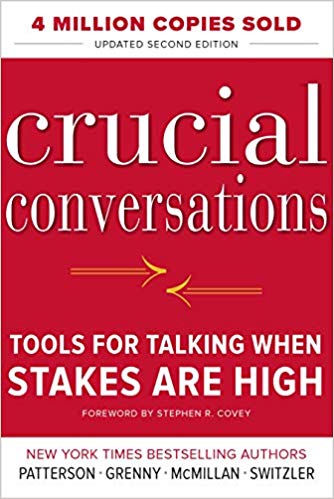

This article is an excerpt from the Shortform summary of "Crucial Conversations" by Kerry Patterson. Shortform has the world's best summaries of books you should be reading.
Like this article? Sign up for a free trial here .
What are the Crucial Conversations 7 principles? What can the 7 principles teach you about communication?
The Crucial Conversations 7 principles are a series of tools that can help guide you through difficult conversations. The Crucial Conversations 7 principles make an easy-to-follow list that you can apply to your own communication skills.
What Are the Crucial Conversations 7 Principles, and Why Do They Work?
In Crucial Conversations: Tools For Talking When The Stakes Are High, authors Kerry Patterson, Joseph Grenny, Ron McMillan, and Al Switzler argue that many problems are caused by how people behave when they disagree with others about high-stakes, emotional issues. Organizational performance and the quality of relationships improve significantly when people learn the skills to handle these crucial conversations effectively.
A crucial conversation is a discussion characterized by high stakes, differing opinions, and strong emotions. Crucial conversations are often typical daily interactions as opposed to planned, high-level meetings. These conversations can have a huge impact on your life. Examples include: ending a relationship, asking a roommate to move out, resolving an issue with an ex-spouse, confronting a coworker about his/her behavior, or giving the boss critical feedback.
We often try to avoid having these conversations because we’re afraid we’ll make matters worse. And in fact, when we do have crucial conversations, we usually handle them badly. We behave our worst at the most critical moments. We may withdraw, or rage and say things we later regret. This is where the Crucial Conversations 7 principles can help.
We typically fail at these conversations because:
- Nature works against us. When under stress, we get an adrenaline surge and blood is diverted from the brain to muscles so that our thinking ability suffers.
- We get caught off guard. Crucial conversations often catch us by surprise — we have a knee-jerk reaction and later end up wondering, what was I thinking?
- We lack the right skills. We don’t know where to start in terms of responding to or initiating a crucial conversation, so we just plunge in.
- Our reaction is self-defeating. We act in ways that keep us from getting what we want. We’re our own worst enemies. For example, when one partner is neglecting the other, the aggrieved partner may respond with sarcasm and sniping — which causes the offending party to spend even less time with him or her.
But this doesn’t have to happen. People can learn the skills to handle these conversations effectively. And when they do, their career, health, personal relationships, and their organization or company benefit tremendously.
For crucial conversations to be constructive, they must have a shared purpose and the conditions must be safe for everyone to contribute. It’s important that all parties participate in order to reach the best conclusion or outcome. Many conversations, however, go off the rails as people act out by pushing their views aggressively, withholding their views, or acting from motives that undercut the shared purpose.
Specifically, there are seven key dialogue principles, including implementation skills you can learn.
The Crucial Conversations 7 Principles
The Crucial Conversations 7 principles aren’t hard to understand. Using these main principles, you can use crucial conversations skills to form better dialogues and communication channels.
1. Know Your Heart
The first of the Crucial Conversations 7 principles is to know your heart. In high-risk discussions, stay focused on what you really want (your big-picture goal, such as a stronger relationship), so you don’t get sidetracked by conversational games, such as trying to win, punish the other person, or keep the peace.
Also, refuse the fool’s choice of limiting yourself to an either/or alternative (I can stay silent and keep the peace, or I can speak up and ruin my relationship). Look for ways to do both: speak up and have a stronger relationship.
2. Make the Conditions Safe
Second on the list of Crucial Conversations skills is to make the conditions safe. The first prerequisite for healthy dialogue is safety. You can’t have constructive dialogue when people don’t feel safe, because they start acting in unproductive ways and stop contributing to the dialogue. To maintain safety in a conversation, you must monitor two elements: what’s being discussed and what people are doing in response — both the content and the conditions of the conversation.
To ensure safe conditions for conversation:
- Notice the point when a conversation turns crucial, and could go off track due to emotional responses.
- Look for safety problems (people withdrawing or behaving aggressively) that short-circuit dialogue, and intervene before they get out of hand.
- Beware of reverting to your style under stress. In crucial conversations, you’ll revert to tactics you grew up with (debate, silent treatment, manipulation, etc.). You need to be alert to these tendencies in order to counteract them.
3. Make the Content Safe
For people to feel safe in speaking their minds, there are two requirements: 1) a mutual purpose for the conversation (agreement on what we’re trying to accomplish); and 2) mutual respect — each participant’s views and feelings are respected.
When someone doesn’t feel safe in saying something potentially controversial, either they don’t trust in a mutual purpose (they’re suspicious of ulterior motives), or someone has undermined mutual respect (for instance, by attacking another person, sighing, or eye-rolling). The dialogue can’t resume until respect has been restored.
You need to clarify or rebuild mutual purpose if your motives and goals, or someone else’s, seem to be suspect. Use CRIB skills:
- Commit to seek out a mutual purpose (commit to stay in dialogue until finding something that satisfies everyone)
- Recognize the purpose behind the strategy (ask people why they want what they’re pushing for)
- Invent a mutual purpose (if you’re still at odds)
- Brainstorm new strategies (with a clear mutual purpose)
When you need to repair a misunderstanding to restore respect, you can use the skill of contrasting. Contrasting is a don’t/do statement that:
- Addresses others’ concerns that you don’t respect them or that you have a malicious purpose.
- Confirms your respect or clarifies your real purpose (the do part).
An example of contrasting in a couple’s conversation: “I don’t want to suggest that this problem is yours. I think it’s ours. I don’t want to put the burden on you. What I do want is to be able to talk so we understand each other better.” Making the content safe can also help you work on the other Crucial Conversations 7 principles.
4. Control Your Emotions
Our emotions are generated by “stories” we tell ourselves when someone does or says something. These stories are our interpretations of what we saw and/or heard. Negative interpretations lead to negative feelings and then to unproductive actions.
But we can change our emotions by rethinking our stories, or retracing our path from our feelings and actions back to the incident that prompted them: notice your behavior, identify your feelings, analyze the story creating your feelings, and go back to facts (ask yourself, what evidence you have to support your story, and whether the facts might support a different story or conclusion). Also, make sure you’re telling yourself the full story, and haven’t omitted any facts to justify your reaction.
5. Share Your Stories
Express your views (tell your story) in such a way that others will be receptive, encourage feedback, and be willing to alter your views or story when additional facts warrant. When caught up in unproductive emotions and actions, retrace them to the facts to test their accuracy.
This process can be broken down as follows, remembering the acronym STATE:
- Share your facts: Start with the least controversial.
- Tell your story: Explain what you’re beginning to conclude.
- Ask for others’ paths: Encourage others to share both their facts and their stories.
- Talk tentatively. State your story as a story (your opinion), not a fact.
- Encourage testing: Proactively seek opposing views, so you can test your theory against additional information.
6. Explore Others’ Paths
To have a constructive conversation, you need to encourage, listen to, and understand others’ views. Start with an attitude of curiosity and patience. Use four listening skills to trace the other person’s path to action (AMPP). AMPP is one of the Crucial Conversations skills where you also get a helpful acronym.
- Ask: Express interest in the others’ views.
- Mirror: Acknowledge the emotions people appear to be feeling.
- Paraphrase: Restate what you’ve heard.
- Prime: If others hold back, offer a guess as to what they may be thinking and feeling to get the discussion started.
As you begin to share your views, remember ABC:
- Agree: Agree when you share views for the most part, rather than arguing over minor points of disagreement.
- Build: Agree where you can, then build. (“I agree completely. In addition, I noticed that…”)
- Compare: When you differ substantially, compare your two views. (“I think I see things differently. Let me explain.”)
7. Move From Conversation to Results
Once everyone contributes his or her information to a crucial conversation, the final step is action. All the conversational effort is moot unless there’s an action plan and follow-through to achieve results.
Groups often fail to convert the ideas into action and results for two reasons:
- They aren’t clear on how decisions will be made.
- They fail to act on the decisions they do make.
To move from ideas to action, first choose the decision-making method:
- Command: With command decisions, it’s not our job to decide what to do, only how to make it work. Decisions are made with no involvement whatsoever.
- Consult: Decision makers invite others to influence them before they make their choice. They consult with experts, a representative population, or even anyone who wants to offer an opinion.
- Vote: Voting is appropriate where efficiency is the highest goal, and you’re selecting from a number of good options.
- Consensus: You talk until everyone agrees to one decision. This method can produce unity and high-quality decisions, or it can be a big waste of time.
Additional steps are:
- Make assignments: Determine who will do what, by when. Assign a name and a deadline to every responsibility.
- Follow-through: Agree on how often and by what method you’ll follow up on an assignment.
Document: After all your hard work in crucial conversation, don’t depend on memory to ensure follow-through. Write it down, keep tabs, and hold people accountable
The Crucial Conversations 7 principles can help you approach a crucial conversation with empathy and respect. The 7 principles are there whenever you need them, and can always serve as a reference for tough conversations.

———End of Preview———
Like what you just read? Read the rest of the world's best summary of Kerry Patterson's "Crucial Conversations" at Shortform .
Here's what you'll find in our full Crucial Conversations summary :
- How to approach an argument without getting mad
- The mistakes most people make when trying to listen to someone else
- How to come up with win-win solutions that make everyone happy






